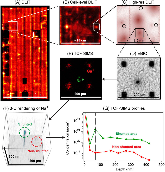Investigating PID shunting in polycrystalline silicon modules via multiscale, multitechnique characterization
- National Renewable Energy Lab. (NREL), Golden, CO (United States)
- Colorado School of Mines, Golden, CO (United States)
Abstract We investigated the potential‐induced degradation (PID) shunting mechanism in multicrystalline‐silicon photovoltaic modules by using a multiscale, multitechnique characterization approach. Both field‐stressed modules and laboratory‐stressed mini modules were studied. We used photoluminescence, electroluminescence, and dark lock‐in thermography imaging to identify degraded areas at the module scale. Small samples were then removed from degraded areas, laser marked, and imaged by scanning electron microscopy. We used simultaneous electron‐beam induced current imaging and focused ion beam milling to mark around PID shunts for chemical analysis by time‐of‐flight secondary‐ion mass spectrometry or to isolate individual shunt defects for transmission electron microscopy and atom‐probe tomography analysis. By spanning a range of 10 orders of magnitude in size, this approach enabled us to investigate the root‐cause mechanisms for PID shunting. We observed a direct correlation between recombination active shunts and sodium content. The sodium content in shunted areas peaks at the SiN X /Si interface and is consistently observed at a concentration of 0.1% to 2% in shunted areas. Analysis of samples subjected to PID recovery, either activated by electron beam or thermal effects only, reveals that recovery of isolated shunts correlates with diffusion of sodium out of the structural defects to the silicon surface. We observed the role of oxygen and chlorine in PID shunting and found that those species—although sometimes present in structural defects where PID shunting was observed—do not play a consistent role in PID shunting.
- Research Organization:
- National Renewable Energy Laboratory (NREL), Golden, CO (United States)
- Sponsoring Organization:
- USDOE Office of Energy Efficiency and Renewable Energy (EERE), Renewable Power Office. Solar Energy Technologies Office
- Grant/Contract Number:
- AC36-08GO28308; DE‐AC36‐08GO28308
- OSTI ID:
- 1427356
- Alternate ID(s):
- OSTI ID: 1436888
- Report Number(s):
- NREL/JA-5K00-70168
- Journal Information:
- Progress in Photovoltaics, Journal Name: Progress in Photovoltaics; ISSN 1062-7995
- Publisher:
- WileyCopyright Statement
- Country of Publication:
- United States
- Language:
- English
Web of Science
Non-destructive approach for severity investigation of shunts in crystalline silicon photovoltaic modules by combination of electroluminescence imaging and lock-in thermography
|
journal | February 2019 |
Investigation on Potential-Induced Degradation in a 50 MWp Crystalline Silicon Photovoltaic Power Plant
|
journal | October 2018 |
Similar Records
Analytical (S)TEM Studies of Defects Associated with PID in Stressed Si PV Modules
Sodium accumulation at potential-induced degradation shunted areas in polycrystalline silicon modules







